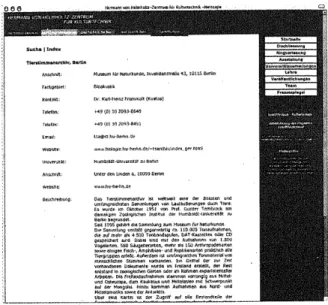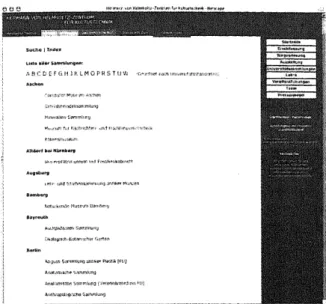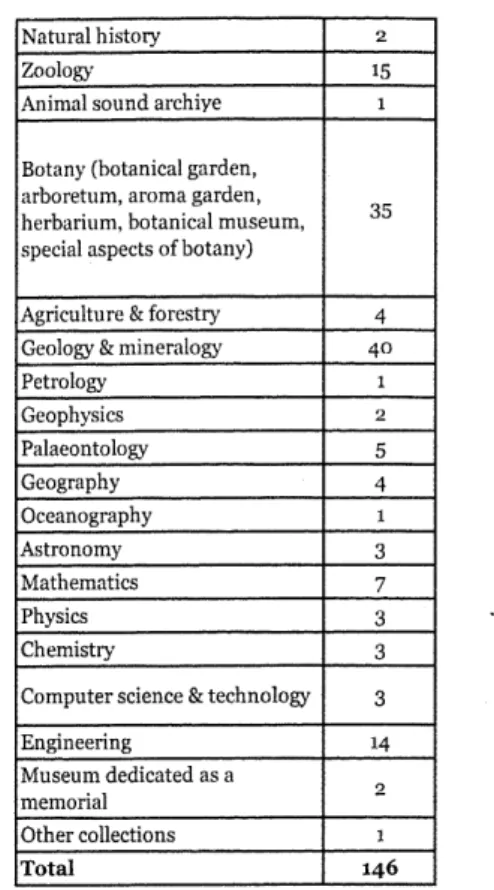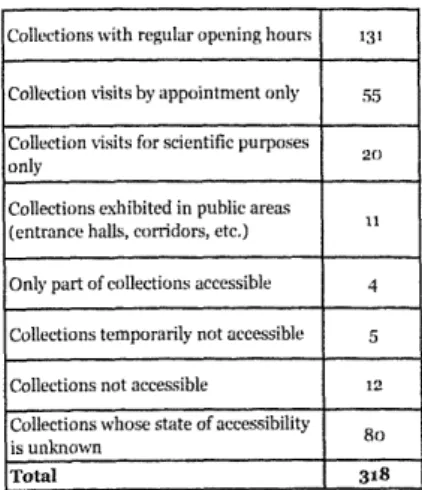MUSEOLOGIA 3: 45-50
A renaissance of German university collections
CORNELIA WEBER*
Resumo
As universidades alemâs albergarti colecçôes notâveis, algumas de interesse locai e outras de imenso valor académico.
Recentemente, as colecçôes universitârias alemâs têm atraido considerâvel interesse, quer por parte da academia, quer por parte do publico em gérai. Este interesse é materializado no substancial aumento do nùmero de visitantes as exposiçôes, bem corno no financiamento de novos projectos. Os chamados 'novos media' têm desempenhado um papel significativo neste 'despertar', possibilitando novas formas de acesso as colecçôes a partir de qualquer parte do mundo, bem corno urna re-invençâo do papel destas no ensino e na investigaçâo. Este artigo traça em linhas gérais o panorama das colecçôes das universidades alemâs e descreve sumariamente alguns projectos de tecnologias digitais actualmente em curso.
Abstract
German universities' host many remarkable collections, some being of local interest only, while others are of immense academic value. In recent years, university collections have attracted considerable interest by both academics and general public. This interest has been highlighted by well-attended exhibitions and well-funded projects for the utilization of collections. A central role in this renewed interest has been played by the so-called 'new media', which provides new ways to access collections worldwide as resources for research and teaching. This paper presents an overview of current collections of German universities and introduces various projects involving digital media.
Introduction
Many German universities harbour considerable academic and cultural heritage in the form of collections and museums. Often assembled over a number of centuries, these collections and museums are of great value as resources for research and teaching, as well as being monuments of scientific endeavour in themselves. In many cases, these collections are equally valuable in a monetary sense.
Nevertheless, university collections have not played^
a particular important role in intellectual life in Germany during the last decades. Only recently,
after drawing attention to and publicizing the subject in various ways, university collections have become an object of general interest both to'the academia and to the broader public. We are now experiencing an exciting renaissance and realize that our collections are one of the most effective instruments for the promotion of the sciences and making these accessible to the layman.
Several examples illustrate this renaissance. For instance, the universities of Munster, Greifswald, Dresden, and Gòttingen have published books about their collections1: Berlin initiated an all-
* Cornelia Weber is general manager, researcher and lecturer at the Helmholtz-Zentrum fur Kulturtechnik, Humboldt University at Berlin. Address: Unter den Linden 6, 10099 Berlin, Germany. E-mail: weber@mathematik.hu-berlin.de
1 E g. Museen der Westfàlischen Wilhelms-Universitat Munster (1993), Kulturbesitz und Sammlungen der Ernst-Moritz-Arndt-Umversitat Greifswald (1995), Sammlungen und Kunstbesitz der Technischen Università Dresden (1996), and Ganzfur das Studmm angelegt Die
encompassing project (funded primarily by the Volkswagen Foundation) to make its collections accessible (WEBER 2002); Halle and Berlin exhibited parts of their holdings with great success among the public2; and, Halle3, Freiburg4, Berlin (WEBER 2002) and Rostock5 are currently in the process of creating university museums.
Although German universities are well known for their exceptional collections, no comprehensive overview of these collections existed when the research described in this paper commenced. Of course, many people are experts on the collections relating to their own specialized field of research, but university museums in Germany as a whole are not yet interconnected or represented by a professional association.
A-starting point
On the occasion of the first UMAC conference in Barcelona in 2001, a working group was set up to list and gather basic information concerning existing directories, catalogues and inventories. As a member of this group I set up a directory for German university museums and collections and published the outcome on UMAC's website6. The survey started at the end of 2001. First, a questionnaire was sent to all German universities, of which only a few responded. One apparent reason for this was that many university collections do not have a well-defined place within the university administration. The central university administration is simply unaware of the extent of their own collections. In some cases only a small group of insiders in their respective institutions, such as heads of departments, professors or curators, know about the collections' very existence.
Fortunately these persons often already provide the information on the Web and, therefore, the obvious step was to systematically visit these websites.
The database
All the information was fed into a database, which can be accessed remotely7. Information provided by the database includes the name of the collection or museum8, address, website, and subject; contact person, phone and fax number, email address; name, address and website of the university; a short description of the collection, opening hours, and other matters such as guided tours, permanent and temporary exhibitions, publications, and lectures (Fig. 1). Whenever possible, a direct link to the collection is provided.
Fig. l - Database interface: example of a record (Archive of Animal Sounds, Berlin).
2 In Halle, the exhibition 'Emporium. 500 Jahre Universitat Halle-Wittenberg. Landesausstellung Sachsen-Anhalt' (2002) and in Berlin the exhibition Theatrum naturae et artis. Wunderkammern des Wissens' (2000-2001).
3 Torsten Speler, curator at the University of Halle-Wittenberg, pers. comm., 2002.
4 Dieter Speck, archivist at the Albert-Ludwigs-Universitât Freiburg, pers. comm., 2002.
5 Information from the website of the Archaeological Collection.
" See www.icom.museum/umac
7 See http://www2.hu-berlin.de/kulturtechnik/sammlungsdatenbank.php
8 The purpose of the preliminary database is to facilitate further research. At this stage, no distinction was made between 'collections' and 'museums' and these were jointly entered into the database as 'collections'. For example, the Museum of Natural History at Humboldt University was entered as one single item, as were many other 'isolated collections' in universities.
Renaissance of German collections There are various possibilities to access this
information. The opening page shows an index of the collections sorted by the city of the host university (Fig. 2). A search option enables one to look for the collection's location, name, subject, contact person, university, or keyword(s).
1 B C D E F 6 H J K L M O P R S T U »
Mtdtni bai HUmberfl
Fig. 2 - Database interface: index of the collections sorted by city of the host university.
Facts
The database, still under construction, currently contains 318 university museums and collections9. It is not nearly approaching completion and therefore the interpretation of the material now available should be understood as being preliminary. It is expected that most of the German university collections will be covered by 2003.
In order to analyze the results and basic trends which they reveal, it was necessary to classify the collections and create categories. Unfortunately, a
thesaurus for university museums and collections or any other thesaurus that suits the purpose was not available1". Therefore a simple list has been created, encompassing the following main categories: i) university history, ii) arts &
humanities, iii) sciences & technology; and iv) medicine. The subjects within these categories include the major fields of knowledge. The terms have been chosen to permit a comparatively straightforward classification.
Museums and collections on university history are rare in Germany: of these there are 13 (4%), including three on university detention cells - where students who broke university rules were once interned - and two collections of institutions which are no longer universities11 (Table 1). The category7 arts &
humanities is represented by 120 collections (38%), among which 50 archaeological collections, 26 of which are of classical antiquities (Table 2). The category sciences & technology contains 146 collections (46%), mostly represented by geology/
mineralogy (40) and botany (35), followed by zoology (15) and engineering (14) (Table 3). Finally, the number of medical collections (39, i.e. 12%) is comparatively small, with 10 in the field of history of medicine and 11 in the field of anatomy and pathology. Apart from museums of the history of medicine and in contrast to geological, mineralogical, botanical and archaeological collections, most of the medical collections are usually not open to the public.
Many departmental medical collections are privy to only a few insiders. Therefore, the overview (Table 4) does not reflect the actual number.
Access to the collections is another important factor. At least 226 (71%) of the 318 collections listed are accessible, 131 of these have regular opening hours, 75 can be visited by appointment, and an unknown number merely display objects in public areas (Table 5).
9 Because archives and collections of rare books and manuscripts are usually accessible through libraries, these were excluded from the database.
1 0 To compare collections on an international basis a glossary in English will be essential.
1 1 Former universities of Altdorf and Helmstedt.
General university history
Special aspects of the university history University detention cells
Total
7 3 3 13
Table i - Survey of German university museums and collections: category 'university history'.
Art t r e a s u r e s A r c h i t e c t u r e C u l t u r a l history T h e a t r e studies Theology Palaeography Archaeology
[Prehistorical, Egyptian, Sudan & Orient,
Classical Antiquity (including plaster casts), Christian Archaeology]
N u m i s m a t i c s Papyrology
E t h n o l o g y / E t h n o g r a p h y Music
Sound a r c h i v e Museum dedicated as a m e m o r i a l
T o t a l
2 2
2
• 7 2 2 2
50
9 7 9 4 3
l 1 2 0
Table 2 - Survey of German university museums and collections: category 'arts & humanities'.
Web-based sources do usually not provide information on the use of collections - is the collection primarily used for teaching and research or as a display collection for the general public? Is it a specialized collection for experts only or is the collection in storage? The next step should therefore be to compile a focused questionnaire on collection use, to be sent directly to those managing them.
Natural history Zoology
Animal sound archiye Botany (botanical garden, arboretum, aroma garden, herbarium, botanical museum, special aspects of botany) Agriculture & forestry Geology & mineralogy Petrology
Geophysics Palaeontology Geography Oceanography Astronomy Mathematics Physics Chemistry
Computer science & technology Engineering
Museum dedicated as a memorial
Other collections Total
2 15 l
35
4
4 0 l 2
5 4
l
3 7 3 3 3
14 2 l
146
Table 3 - Survey of German university museums and collections: category 'sciences & technology'.
History of medicine. & pharmacy Anatomy & pathology Anthropology & osteology Anaesthesia
Dermatology Physiology Obstetrics Forensic medicine Special aspects of veterinary medicine
Dentistry
Museum dedicated as a memorial
Total
10 11
5
l 2 1 1 2 2
3
1
39
Table 4 - Survey of German university museums and collections: category 'medicine'.
Renaissance of German collections
Collections with regular opening hours Collection visits by appointment only Collection visits for scientific purposes only
Collections exhibited in public areas (entrance halls, corridors, etc.) Only part of collections accessible Collections temporarily not accessible Collections not accessible Collections whose state of accessibility is unknown
Total
131
55
2 0
11
4 5
12
80 318
Table 5 - Survey of German university museums and collections: accessibility.
Novel ways to access collections
New media provide novel ways to access collections as resources for research and teaching worldwide.
Applications encompass the presentation, publishing and management of digitized content in various electronic formats. Simply putting basic information on a web page already makes its existence globally accessible. If a database with text-, picture-, video- and sound-files is developed, it can be used locally, by intranet or via the Internet. By designing a virtual museum, a visit can be offered independent of time and place. Moreover, interactive pages with special content can be an effective and engaging way to learn.
As mentioned above, during the last few years a renaissance of university collections has taken place in Germany, which can be directly traced to the application of the new media. On the web, presentation and access are now independent of the extent of support provided by the university, its budget and staff, the state of the collection, and the place and time. We are all aware that viewing digitized items is no substitute for glassed-in
12 www.uni-bonn.de/Die-Universitaet/Museen.html
showcases, but the new media provide important tools covering other kinds of information, convey this information to new target groups, and utilize a wider range of resources. Through the new media we can attract the attention needed to promote our collections and provide a reliable basis for further projects.
Today the simplest way of reaching the public is through the use of the Internet. Websites impose virtually no constraints of size or content and there is no trade-off between popularized displays attracting the laymen and the academic sections catering to the professional. Moreover, an endless number of links can lead to related sites and supplemental information.
The analysis of the German university collections shows that many (currently 216, i.e. 68%) are already utilizing the web for their purposes - 19 museums have a page with basic information in order to enable a first contact, 138 have a description that gives a first impression of the collection, 31 provide a tour through a virtual museum and 10 contain a catalogue or a database providing further information. Moreover, 18 university museums have created separate homepages with special offers and services. When this survey was compiled, 102 collections were still not accessible through the web.
The self-portraits of universities on the web illustrate the changing role of university collections in Germany. Under the heading 'The University', the homepage of the University of Bonn, for example, presents the directory 'Museums and Scientific Collections'12. In this case each visitor of the homepage can learn something about the 'hidden treasures' of the university and is not encumbered by an awkward search through the Web pages of numerous institutes.
Assembling and displaying hidden, dispersed or heterogeneous collections in a virtual museum is of great convenience for university collections.
Application of new media allows showing rare and
perishable ancient objects, the virtual simulation of the functions of old machines and the performance of experiments with scientific instruments. Databases of digital objects support research and teaching.
Standardized formats and simple interfaces allow users from every country in the world to find and display information without significant investment in hardware, software or training. Thus, the new media enable university collections to disseminate knowledge to a broader audience than by displaying exhibits in the traditional way.
Scrutiny of the university collections' websites reveals a variety of appealing and useful pages for different target groups. Real 'pleasures for both eyes and ears' for example are offered by the Museum of Musical Instruments at the University of Leipzig13. Another exemplary page comes from the computer science collection at the University of Erlangen-Niirnberg14. The website presents a reconstruction of the calculating machine of Wilhelm Schickard from 1623, and the visitor can learn how to solve arithmetical problems. Ten university collections have put object databases or catalogues on the web for research use - an example is the collection of the Archaeological Museum at the University of Halle- Wittenberg15 . There are also many text-based pages with various essays and some remarkable tours through digital collections. A few universities are even selling replicas of their objects online.
Fundamental to the international exchange of knowledge is the language of presentation. Although German universities are gradually beginning to
provide English versions of their main websites, only few - currently 18 - do present their collections in English. One might conclude that the people in charge of disseminating information do not consider the sometimes specialized areas of academic issues as being of general importance. However, this impression is wrong, as can be seen by international efforts in developing databases for academic matters, for example in the case of BioCase (Biological Collection Access Service for Europe)16. Such initiatives will, in the long run, guarantee the desired impact on the academic world.
A new role in university teaching
In today's world, and above all at universities, multimedia and IT skills are much in demand. Past experiences have shown that students often do not have sufficient media competence. Without further training they will not be able to prepare and present their results in multimedia. In response to the rapidly growing use of digital multimedia applications, the imparting of media competence would be a unique chance for the collections to play a novel and important role in teaching programs. In a university, a collection provides a good tool for learning digital photography and video and creating websites. Humboldt University is currently supporting initiatives introducing new media and improving competence in multimedia. This allowed me to offer a student course entitled 'The application of the new media in cataloguing and presenting collections'. This is an exciting experiment for me and I look forward to bringing the students closer to our university collections.
Reference
WEBER, C. 2002. From independent university collections to a Wissenstheater: an ambitious project at the Humboldt University of Berlin. Museologia 2: 81-88.
13 www.uni-leipzig.de/museum/musik/start.htm M www.iser.uni-erlangen.de/more/Ioooi/index.htm
l5 robertin.altertum.uni-halle.de/astart.html
l° www.biocase.org/



